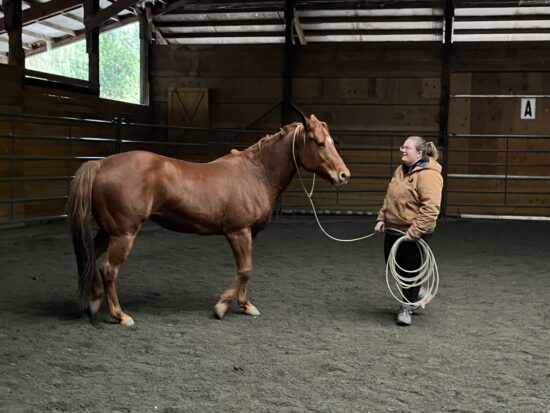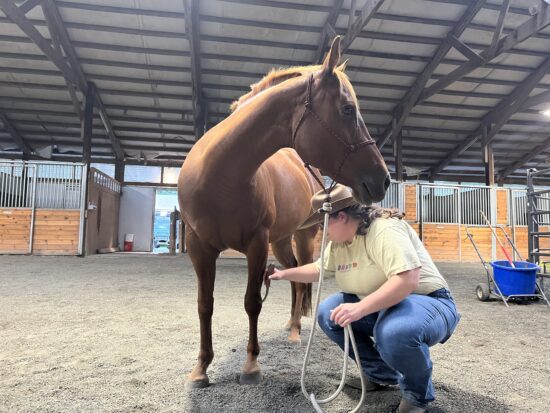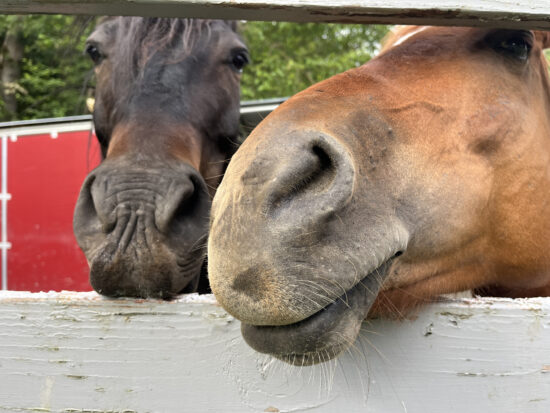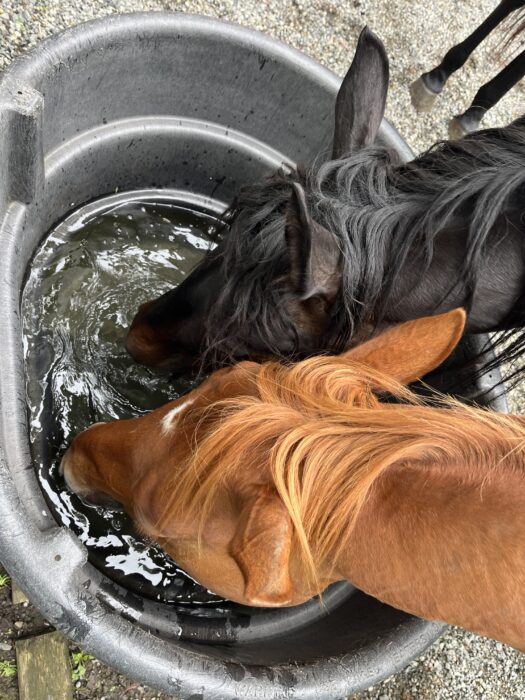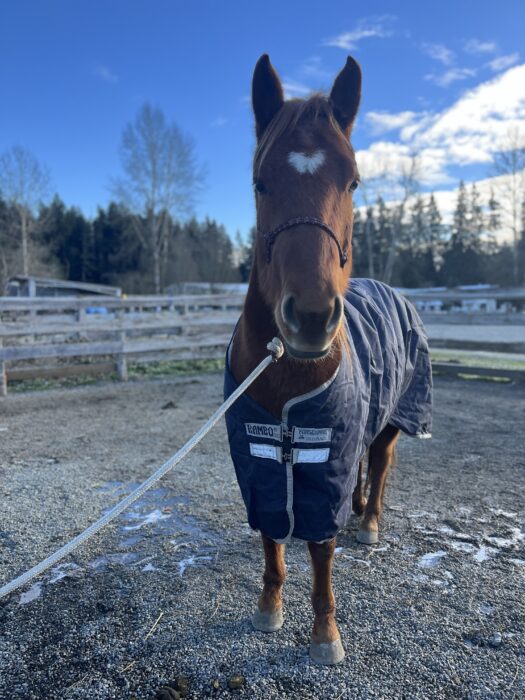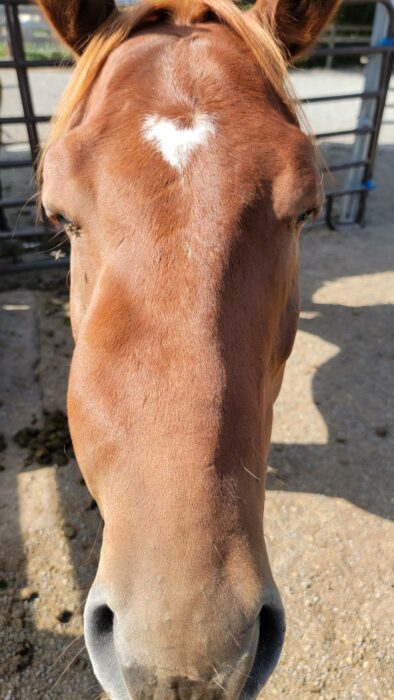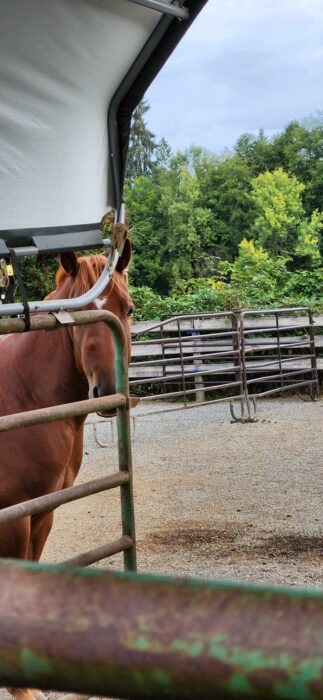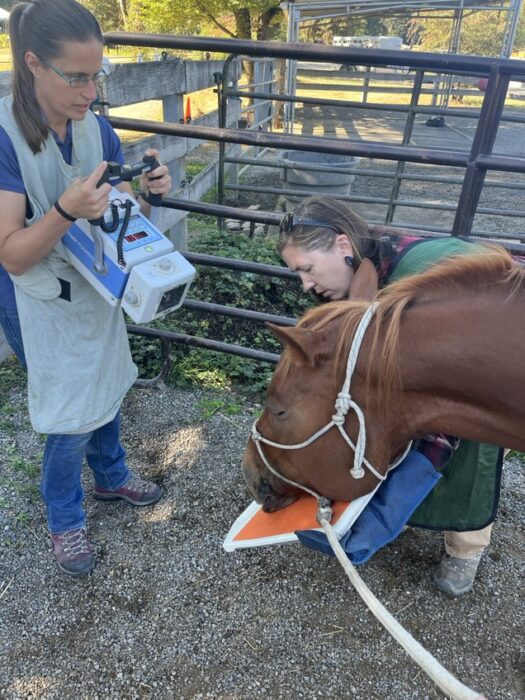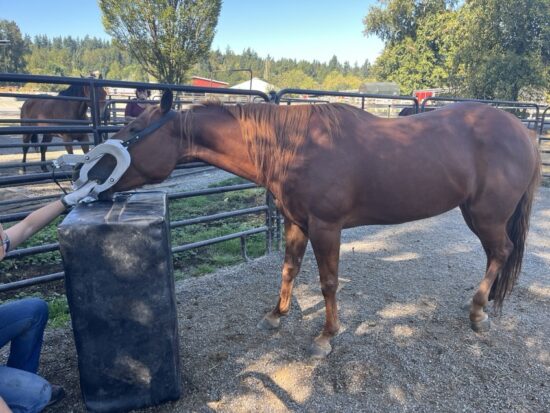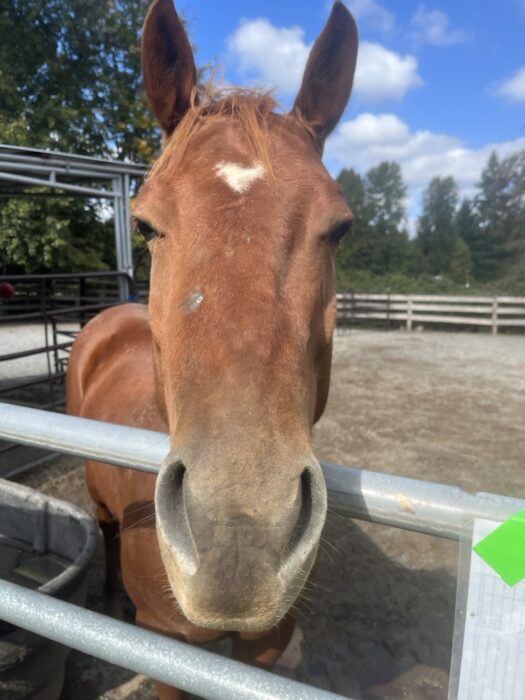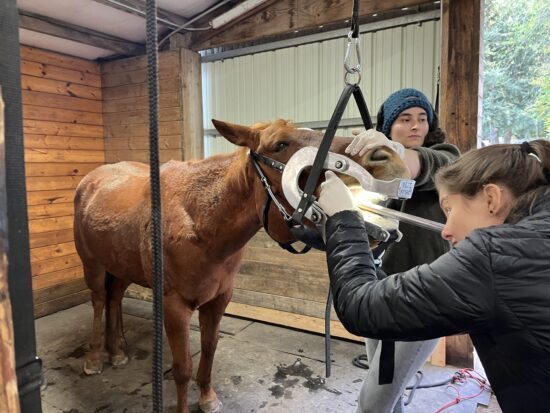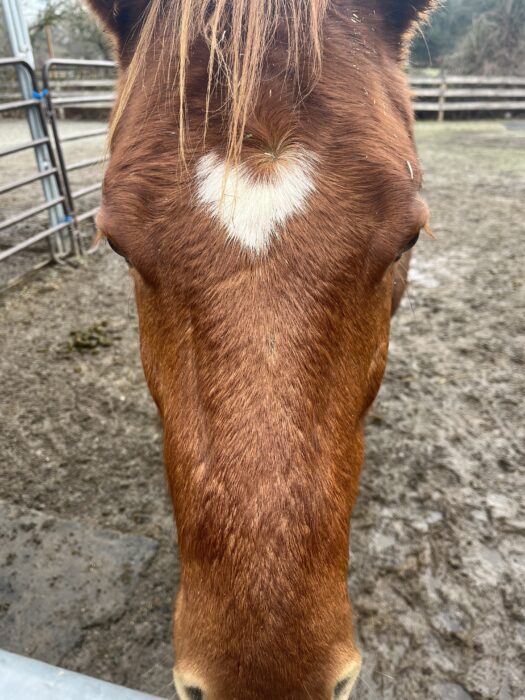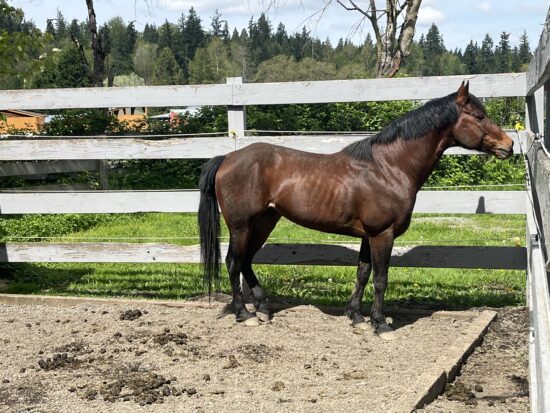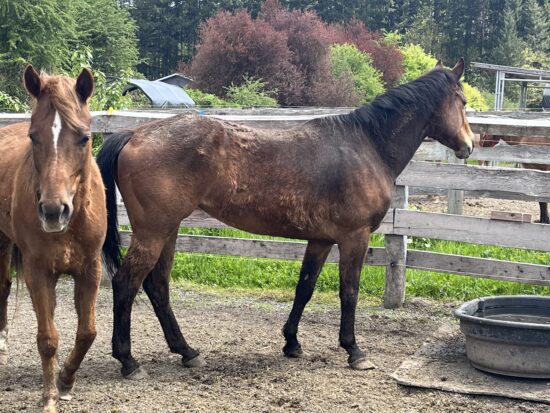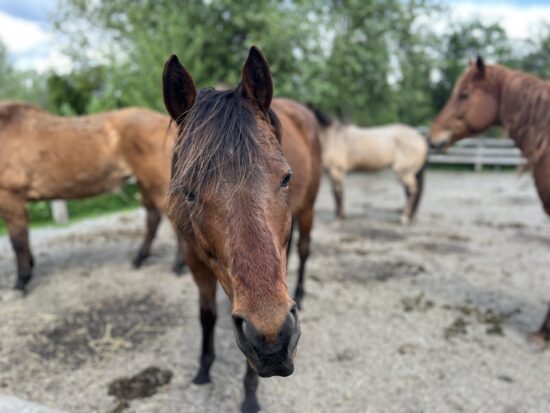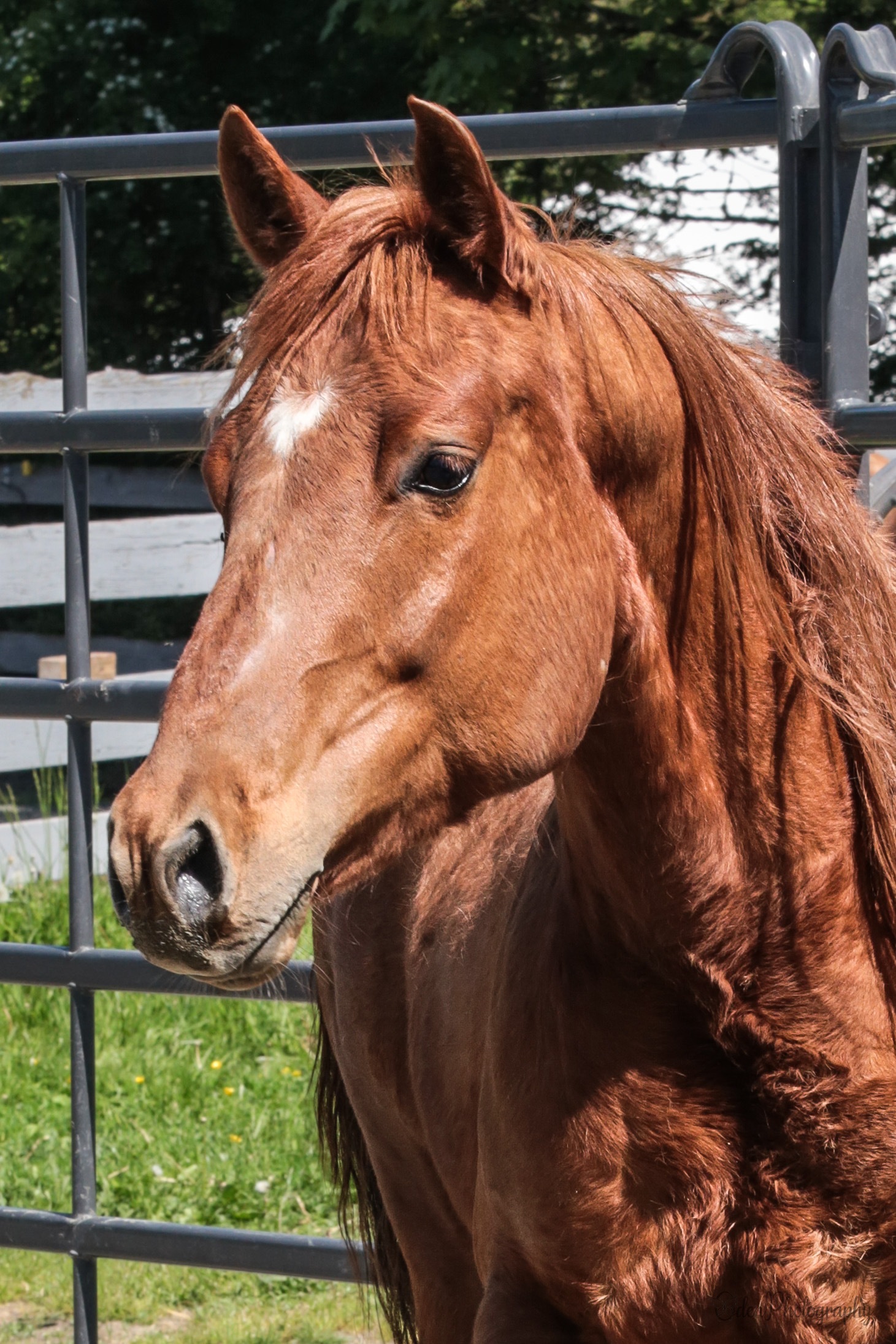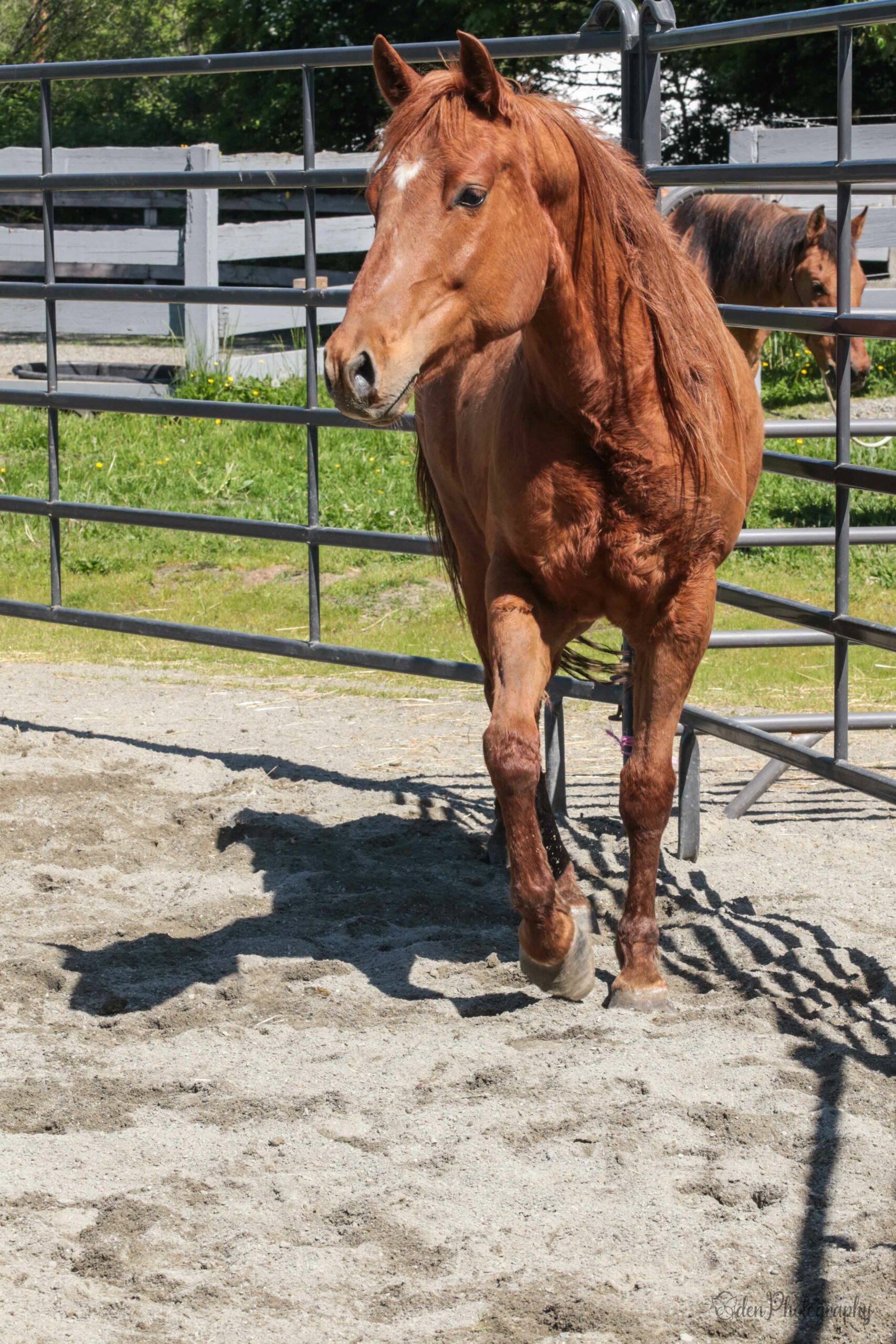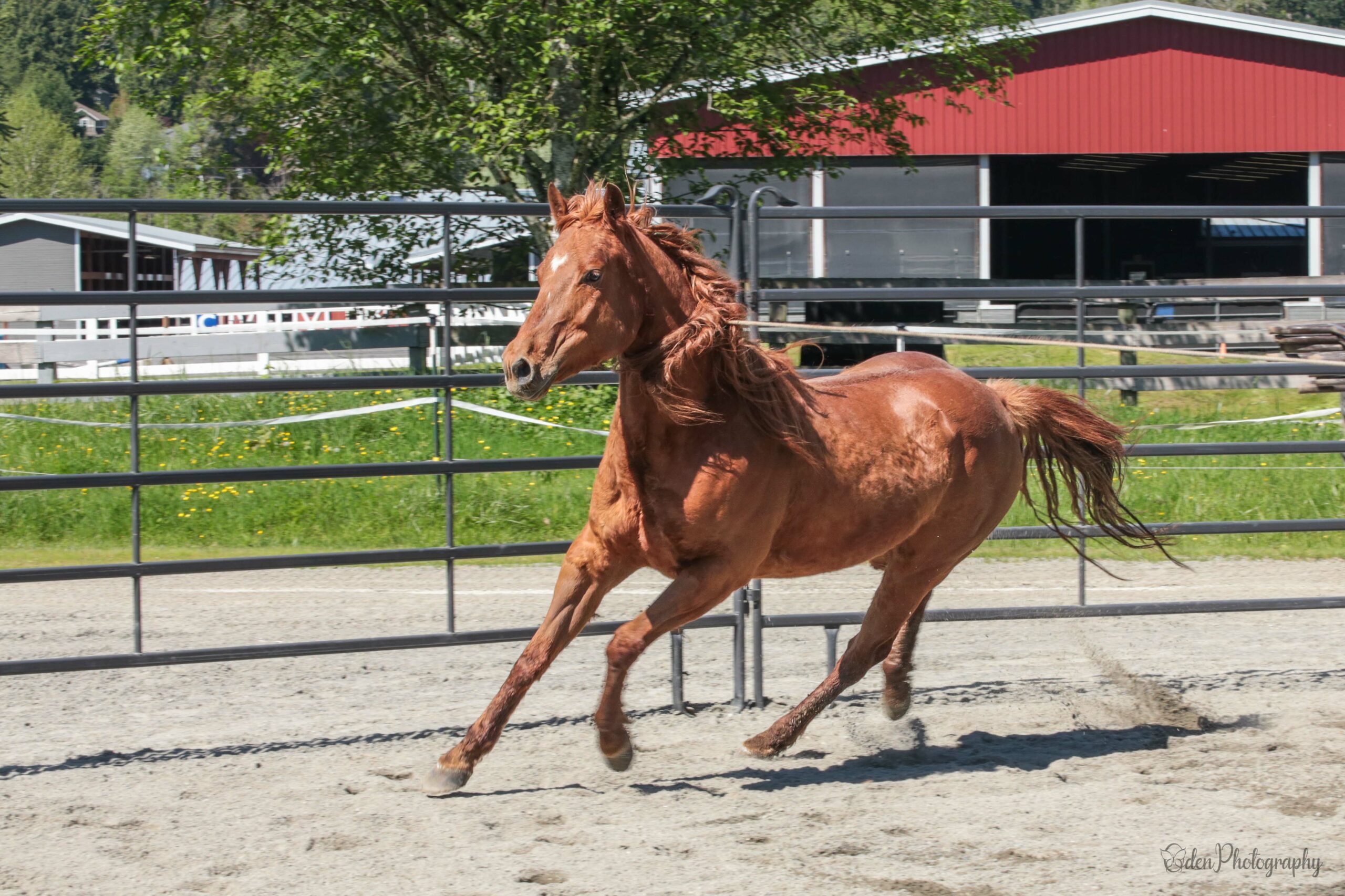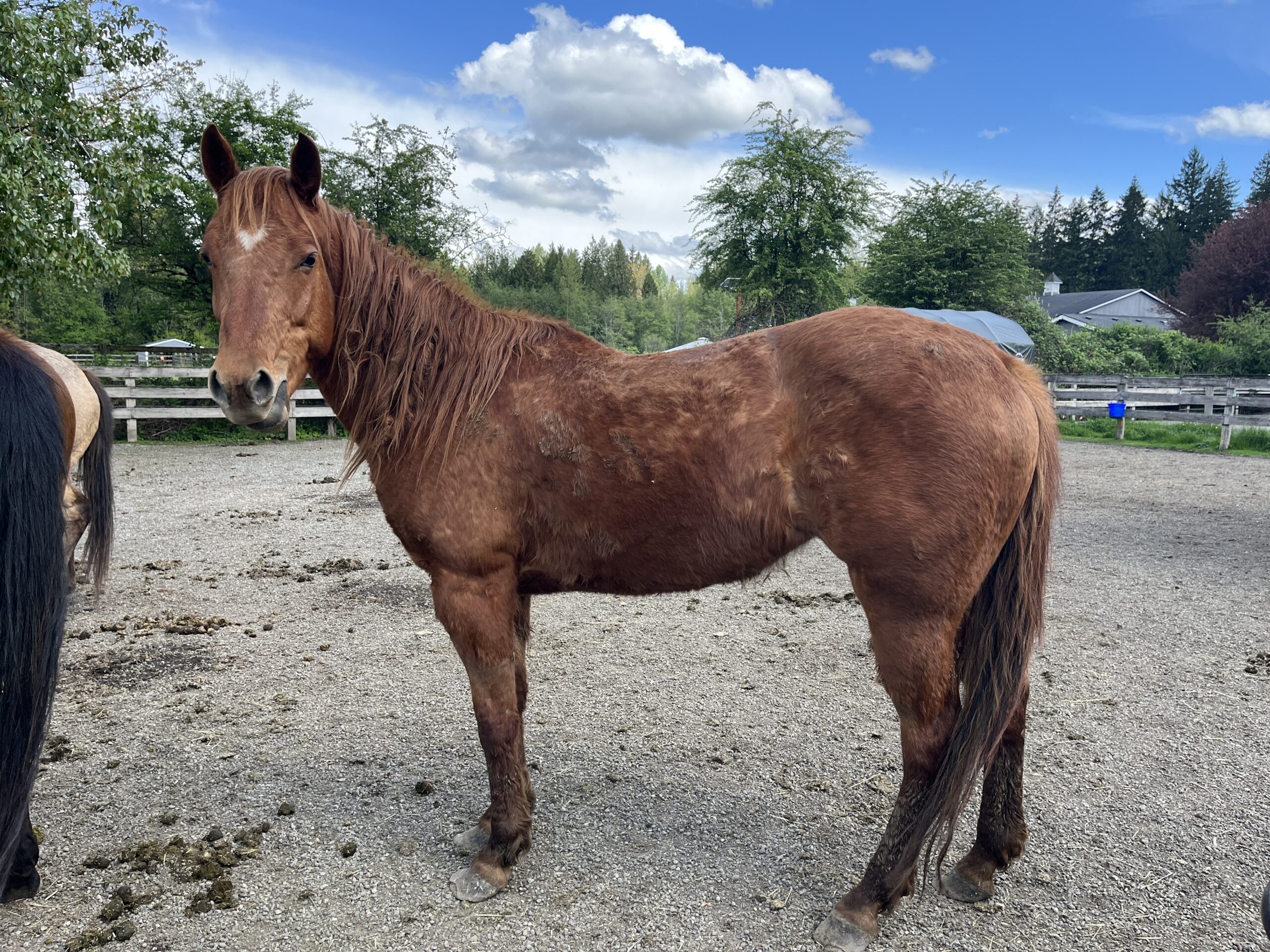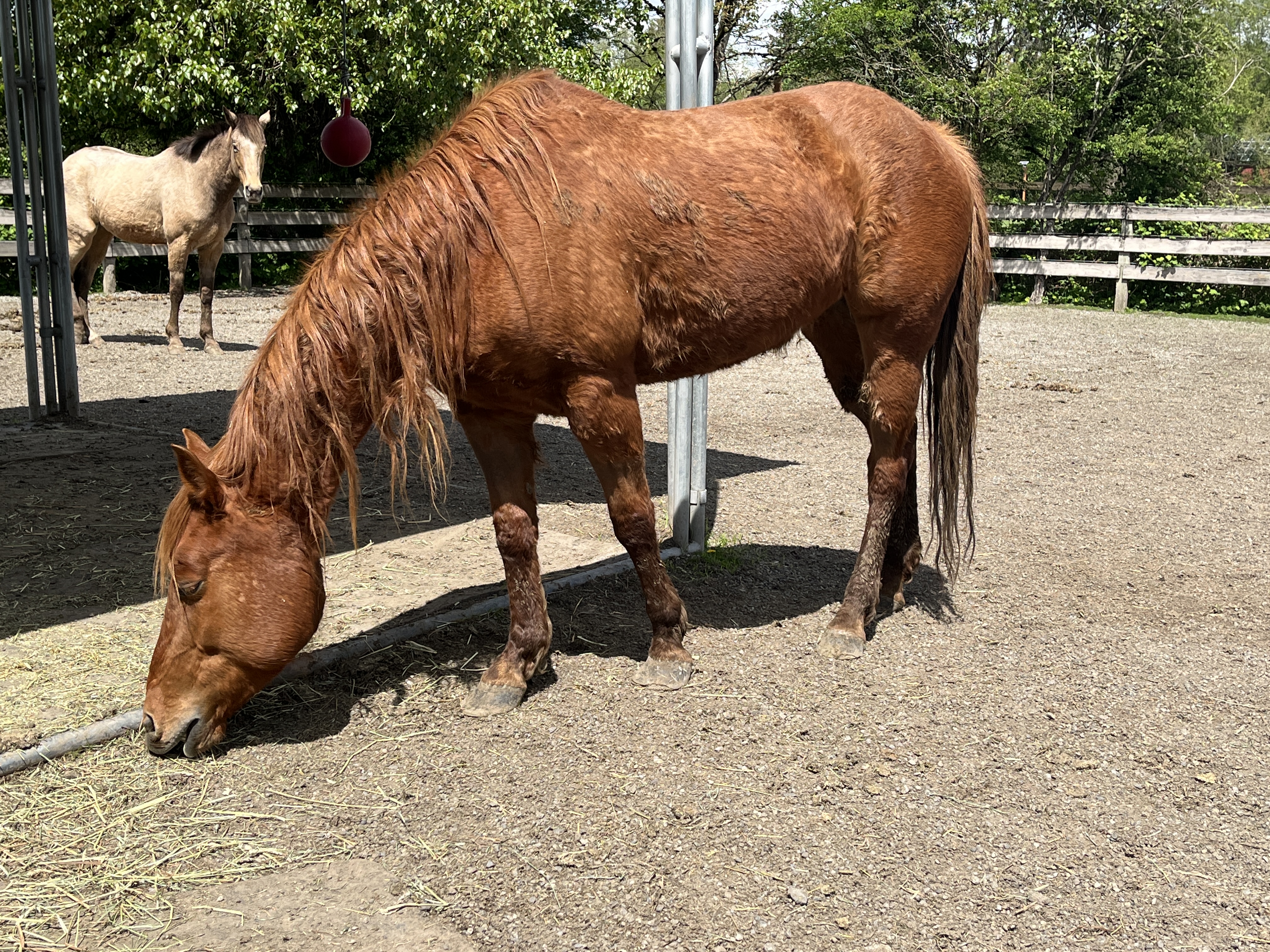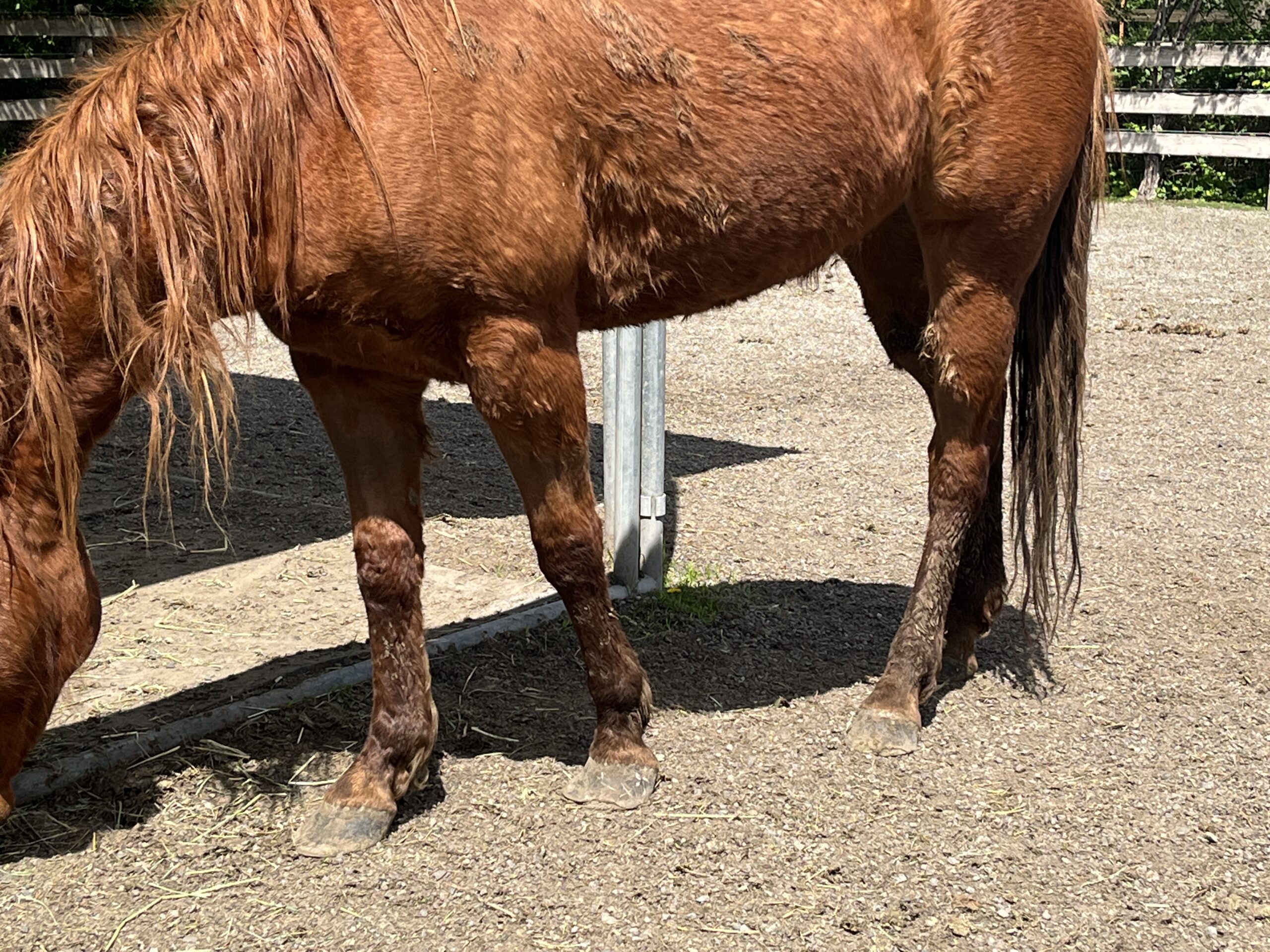Harissa
Quarter Horse mare
Suitability: TBD
Color: chestnut
Markings: heart shaped star
Height: 13.3h
Weight: 800lbs
Adoption Fee: 1500
Harissa came to SAFE in May of 2023 as part of a 7 horse owner surrender situation in the Gig Harbor area. She, along with her 6 herd mates, were living in poor conditions, surrounded by broken panels, standing in deep mud, without clean water.
Without knowing her exact history, Harissa read to us as the most untouched horse of the group — certainly the most unwilling to be touched. Our initial assessment of her was that she was a mare with significant herdboundness, and one who leaned more towards ‘fight’ than ‘flight.’ We decided that what Harissa needed was time, which is what we gave her.
Harissa is a curious mare, and went from figuratively (and literally) barring her teeth at people, to investigating them and what they were doing. Slow and steady wins the race, and we are taking things nice and easy with this mare to ensure she has the best chance of success in her future.
All SAFE horses are adopted with a no-breeding clause, no exceptions.
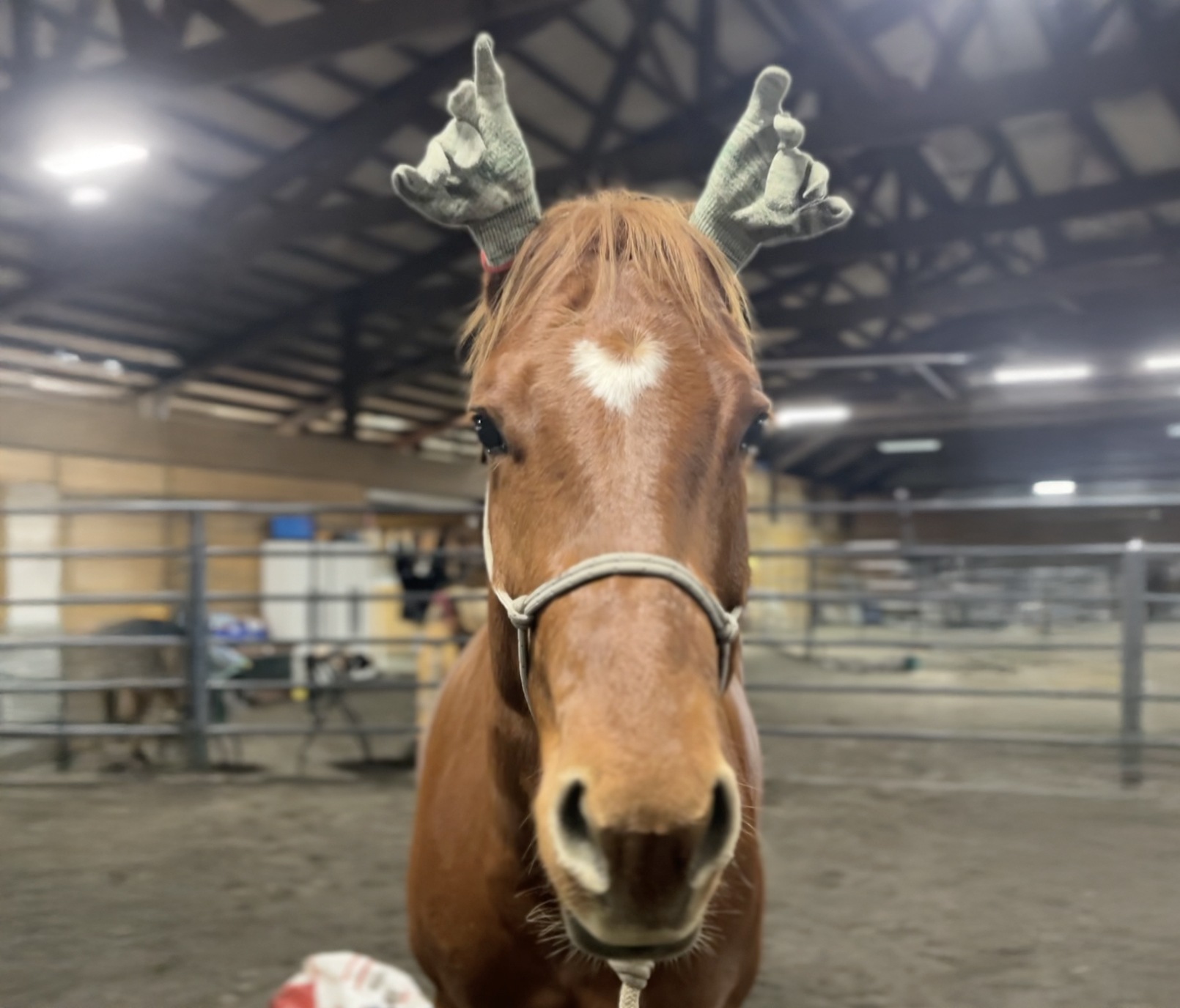
Harissa and the Can Bag
Here is a showcase of Harissa vs. the Can Bag. Clearly, Harissa: 1, Can Bag: 0.
Harissa sure has come a long way in her own self-confidence, and as a result, feels no fear about showing the can bag who is boss! This process of ‘sacking out’ is not just for fun — it is also helping to teach Harissa that the ‘cans’ she encounters out in the world pose her no threat, no matter where they might be: underfoot or overhead. She’s got it in the bag — the can bag, that is.
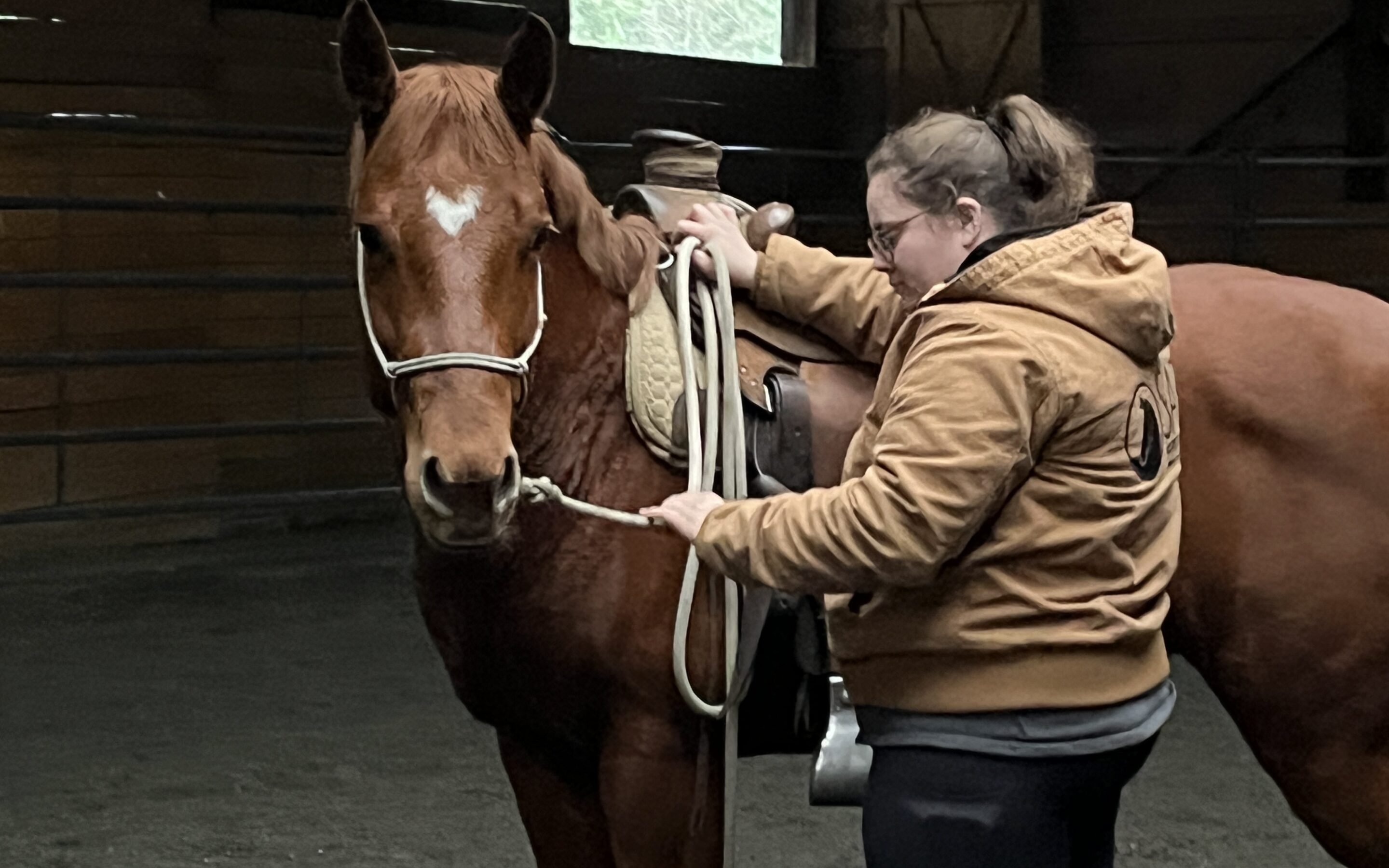
Har Har’s Heart
Lexee N has been working with Harissa for the last several months on the ground, getting her ready for her first saddling. Here’s what she has to say about their time together recently:
“Working with Harissa has been great. She is one classy gal. By classy, I mean she knows what you know and what you don’t. It is truly impressive how much she learns and retains every day after each session. She tries so hard, and once she gets it, it starts to click very quickly. She’s been doing great with the introduction of the saddle, and we’re on track to cinching it up this winter. Right now, I’ve just been throwing it up each day from each side, getting her used to the feel of it.
She still has her funny little quirks. She will still go to nip out of insecurity, but she has come a long way from pushing into pressure and lunging out at people. She comes to greet you at the gate and is always game to come work. Even though she is good buddies with Nova, she doesn’t mind leaving her to come inside for a session.
The little heart on Harissa’s forehead is a miniature replica of what is in her chest. It has been a lot of fun working with this mare and I look forward to what the future holds for her!”
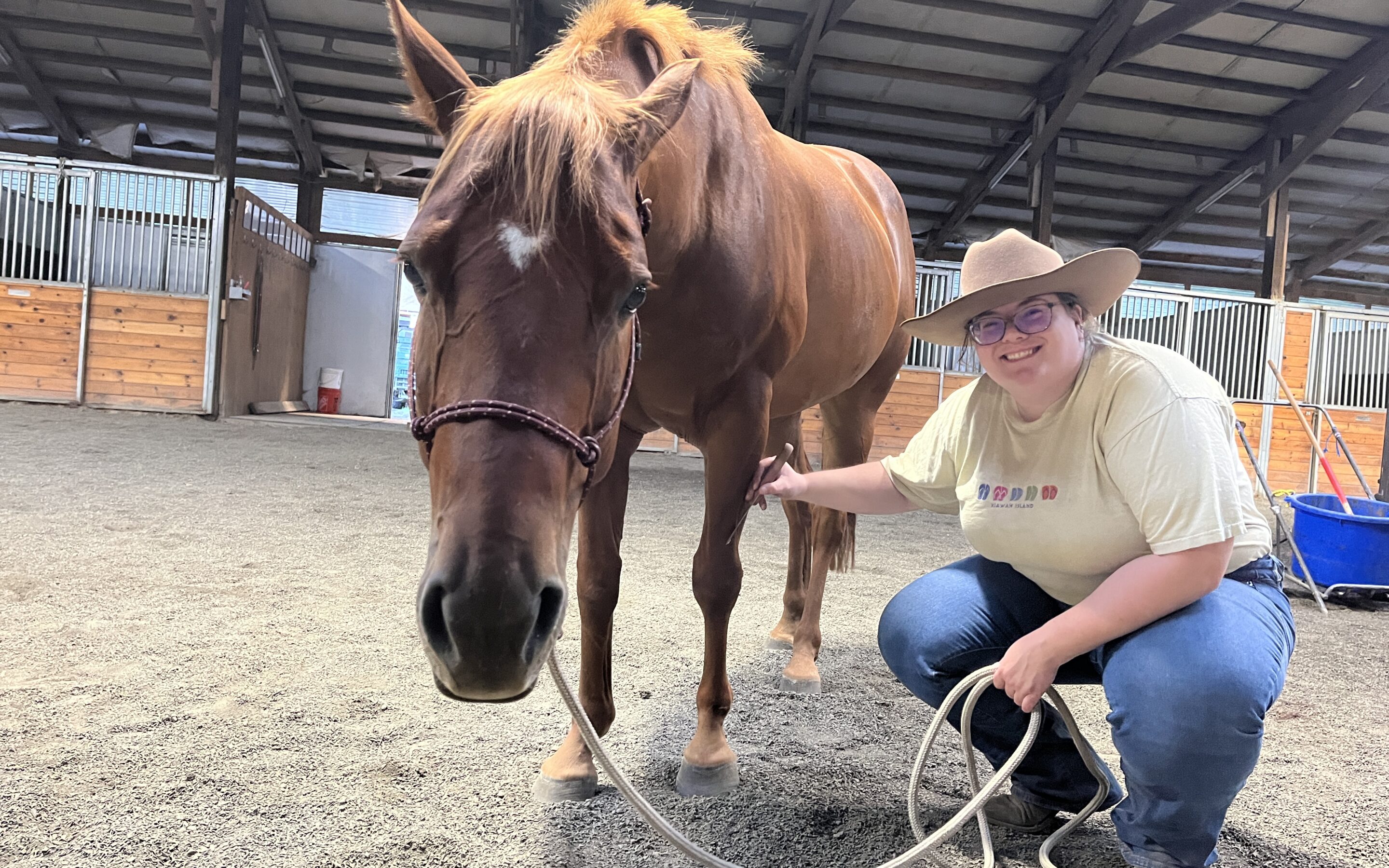
Ain’t No Bugs on Me
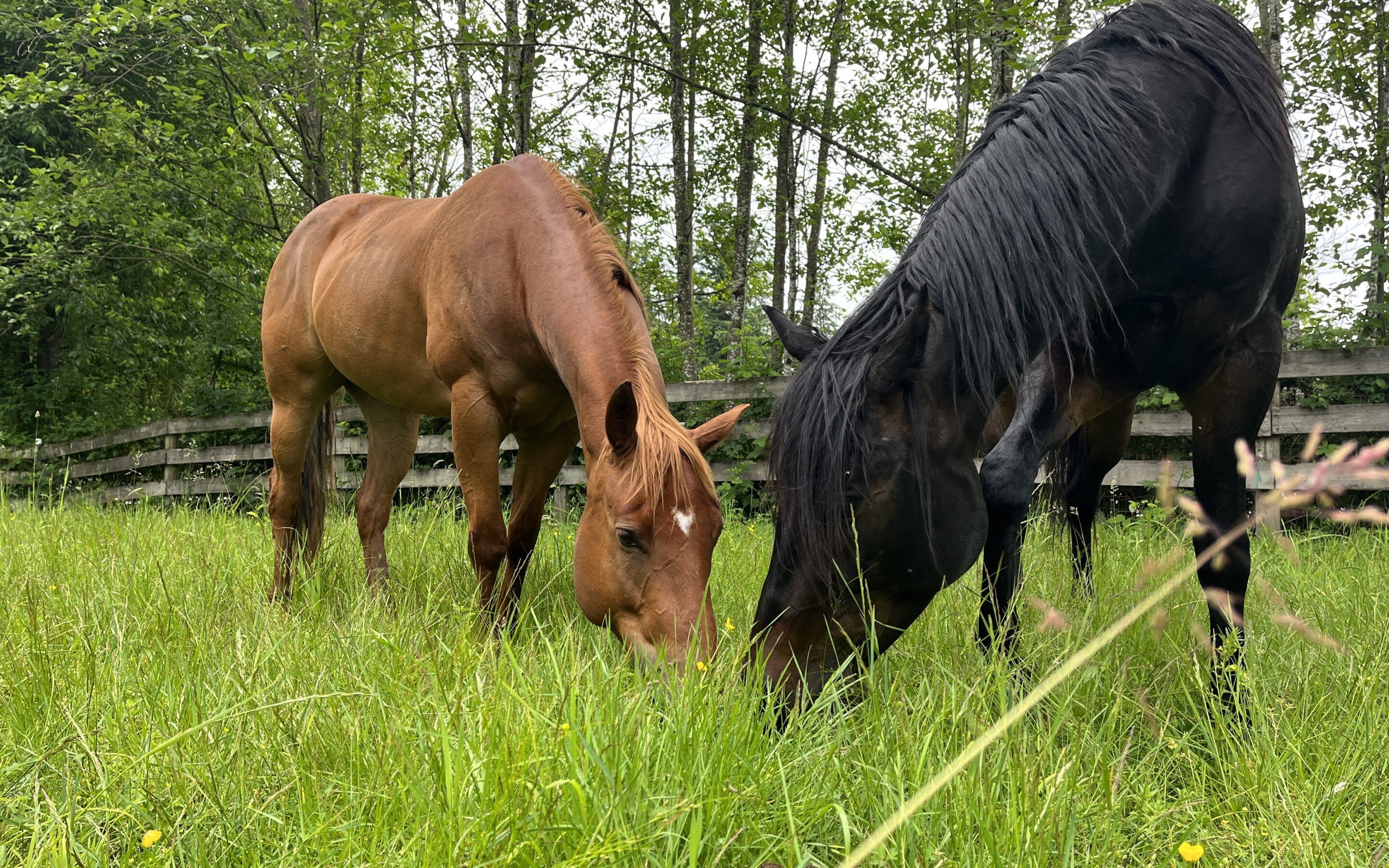
Gals Being Pals
Nova and Harissa have been sharing a fence line for a while now, but recently became officially introduced out in their grass backyard. Neither of these girls are a stranger to herd dynamics, so there was very little fanfare as they established the hierarchy (Harissa > Nova), and ever since have been two little peas in a pod. Nova finally has a reliable companion to itch her withers, and Harissa gets a friend to horse around with, pun intended. We love new friends, and these two ladies are no exception!
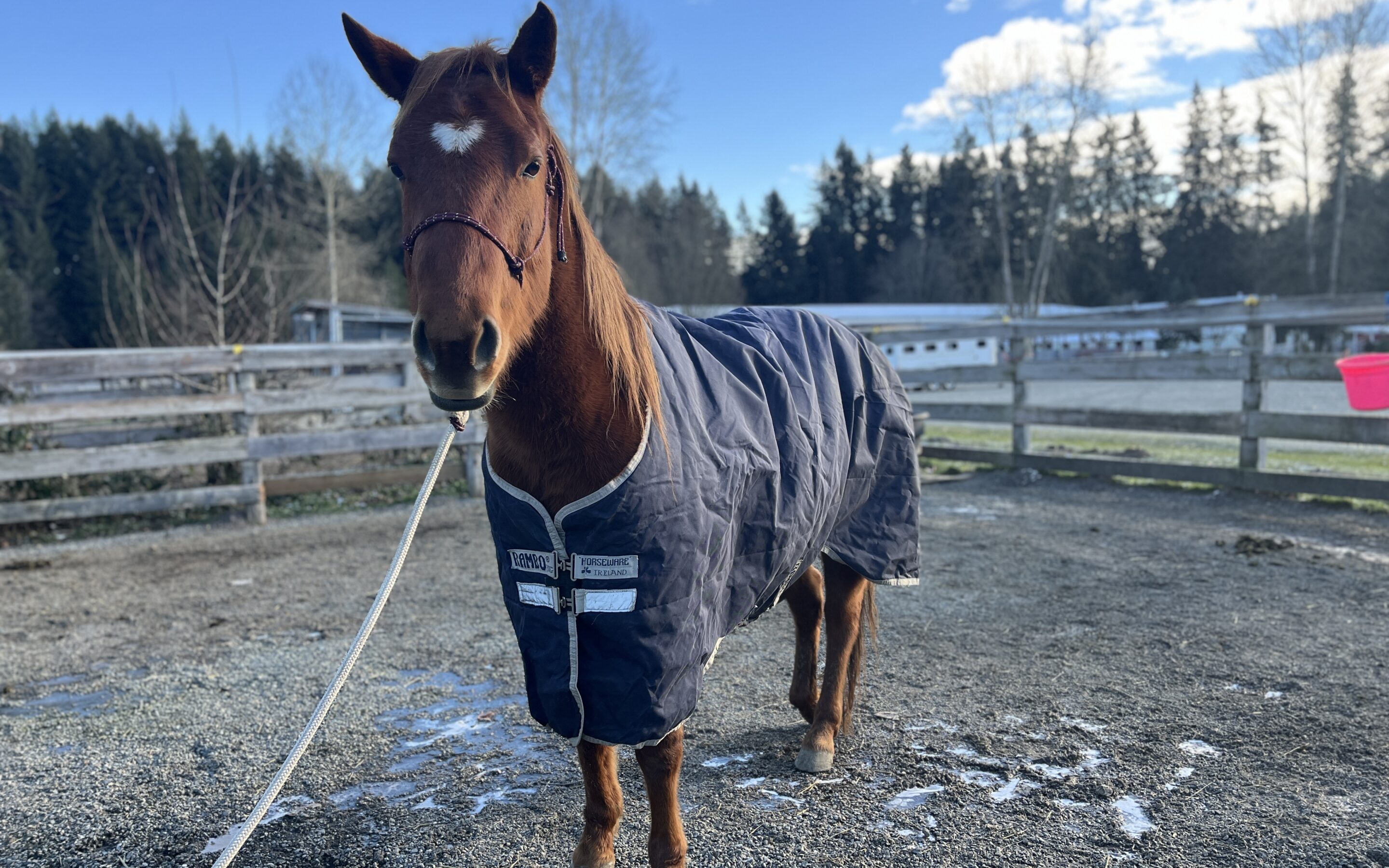
Harrisa, Blanketed
With this recent snap in cold weather, we are doing our very best to keep the horses warm and happy. Extra feedings, steaming sweet waters and hot mashes, blankets with fill — we set our herd up with these things and more to help them combat the cold.
Harissa is still on her journey towards being a truly gentle horse. While she has been coming into the barn to get worked more and more these days, Harissa still spends her days and nights outside. But with the cold front fast approaching, we had to take some action to make sure she would stay nice and toasty despite the drop in temps. While it’s true she does have quite a fuzzy coat, an added layer of insulated protection certainly wouldn’t hurt as the thermometer plummeted into the teens. But how would she be about being blanketed? Fine, it turns out. We eased her into the idea, and the blanket, slowly, checking out that we could touch her with it all over without her being bothered. The care we took was necessary for us to feel comfortable, but not needed for Harissa, who acted as though she’d been wearing a blanket her entire life.
Sometimes, the blanket can become an issue after the fact. Once the horse is released from the halter, the feel of the blanket and its various straps and workings can upset the horse when they start moving around freely. But Harissa was completely unfazed. She even posed for a few pictures in her new dress — looking lovely as ever!
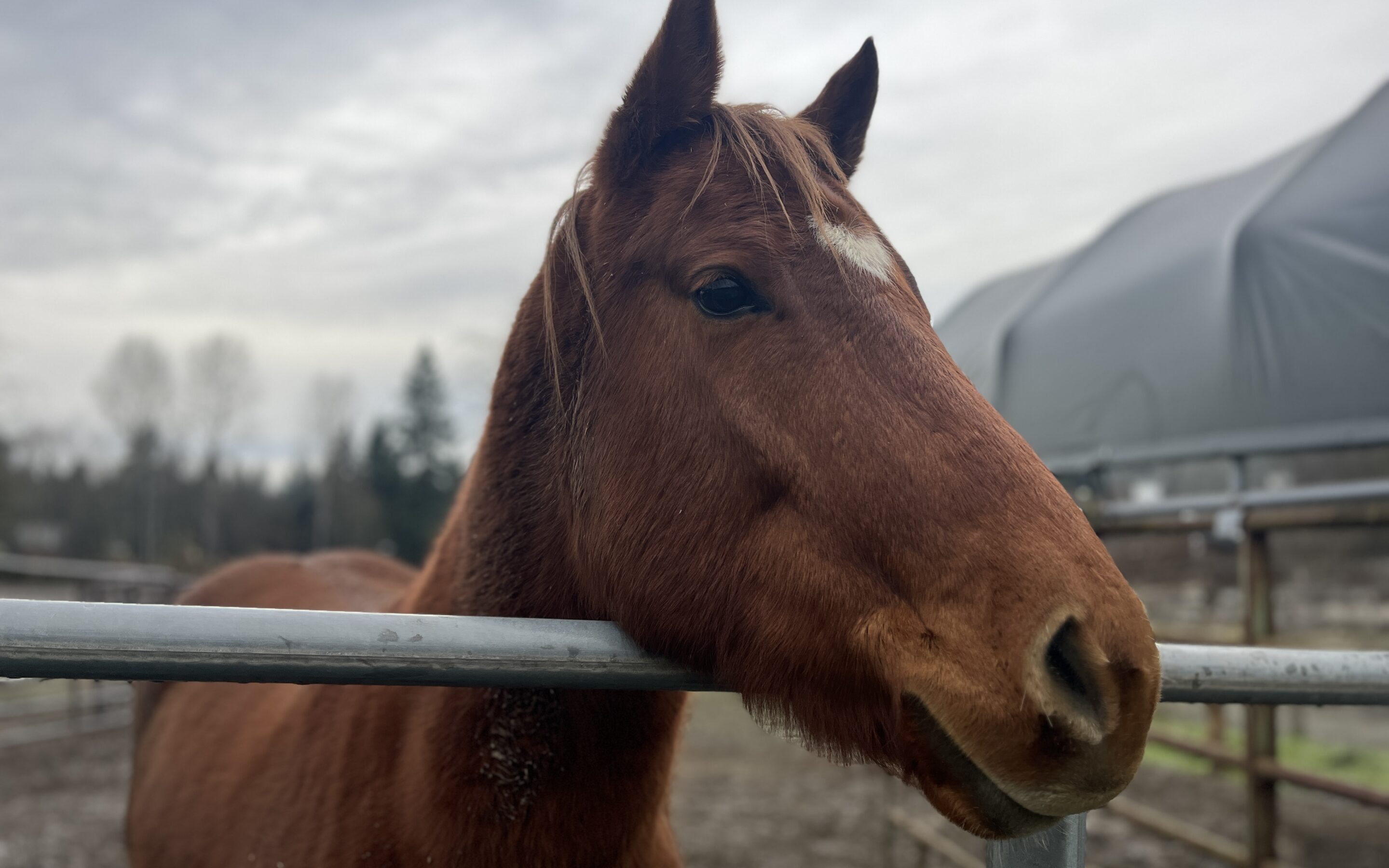
The Saga of Harissa’s Swollen Face
Imagine, for a moment, a slightly better than worst-case scenario that might occur at a horse rescue. Your mind probably jumps to something medical, right? Nothing life-ending (that would be more on the worst-worst-case scenario side) but something dramatic enough that there are some elevated cortisol levels associated with the event. What about something like a mostly untouchable horse who develops an ailment that needs to be seen to? One requiring X‑rays and many vet appointments? If you need help envisioning a scenario, let me regale you.
It began with a bump.
It was the end of August, and the days were still long. Daylight extended past the 6 o’clock hour, and the afternoon chore teams did not yet have to work under the cover of darkness. Golden hour shined down on Harissa, who illuminated like a new penny under the glow of the sun. Like a spotlight, the sun also showed a new addition to her face — a rather large lump. The right side of her face, between nose and eye, distended out like a twisted roman nose. She was still eating well, perhaps not as voraciously as usual, but in a way that didn’t cause a significant amount of concern. For all intents and purposes, she was behaving normally. We gave her a gram of bute for the swelling, and planned to check on her in the morning.
The bute didn’t touch it. Each day, Harissa would greet us with the same level of enthusiasm for her morning meal, the swelling on her face an unwelcome visitor who didn’t seem to be departing any time soon. It was a Friday evening when all of this began (the preferred time for horses to require medical attention: after hours) but throughout the weekend she behaved just as she always had. No change in diet, no new lethargy or unusual habits, no nasal discharge. But the swelling did not go down.
We called the vet first thing Monday morning. Their treatment suggestions mirrored those we had been using: bute. They said it could be either trauma related or something to do with a tooth, and that if she wasn’t having trouble eating, we were okay to monitor it as we worked to get our hands on her. We were reminded of Otto, whose infected tooth caused a similar facial lump. We crossed our fingers that would not be the case for Harissa, and held out hope that it would somehow resolve on its own. As if!
For while Harissa posed prettily for our daily update photos, she still had only a minor amount of handling. It was not uncommon for her to lunge at the individuals hanging her hay net, and even if that wasn’t the case, we had seen her degree of unpredictability first hand. She had yet to have a dental float, and her only time outside her paddock had been spent in the attached round pen, learning the basics of giving to pressure. She was not what we would consider to be halter broke, the list of tools she had to talk her out of trouble able to fit on a post-it note. The thought of leading her into the barn, sedating her for a float, having our vets put a drill in her mouth… all seemed still out of reach. At least, out of safe reach. But this facial swelling was stubbornly set on staying, and while it did not seem to be impacting her quality of life, the waiting game was over, and we had to take action.
Ahead of said action, as if to hurry us along, a secondary bump appeared atop the first one. Things were, quite literally, coming to a head. The vet was able to make it out in a few days, and we discussed a game plan on what we would attempt and how we would attempt it (starts with Dorm and ends with gel). Meanwhile, Harissa continued to eat and drink as normal, though we monitored her closely for any changes.
The next day, a welcome, if not slightly stomach-churning sight: the abscess that had formed the previous day had blown, leaving an unsightly trail of drainage, a little river over the hill of her face. She allowed us to clean her up a bit, but there is only so much poking and prodding of the area we wanted to do. There had to be a degree of relief associated with the expulsion of some pressure, and we eagerly awaited the vet’s opinion.
Harissa needed X‑rays to see what exactly was happening beneath the hood. While they have come a long way X‑rays do require a source of power in order to view the images. Harissa’s paddock was not near a power source, and the nearest outlet did not generate enough juice via extension cord to run the machine (ask us how we know). So Harissa would have to move closer to the power. Ideally, this would look like bringing her inside the barn, but like previously mentioned, her ability to lead was very minimal, and adding in the element of a totally new environment on top of an already stressful situation did not feel like the right move. Instead, we did a bit of musical horses, for there sits a row of paddocks that are easily accessed by an outlet, and where we felt would be a good spot to work, quite literally, in the field.
But this didn’t solve the issue of moving Harissa, which would still have to be done, even if it wasn’t as far or as intimidating as the barn. Over the days leading up to the vet visit, we had been spending more time with Harissa, if only just to halter her and get her used to the idea of leading around a bit. This was all happening when Terry, who has the most experience with difficult horses outside of Joel, was away on vacation, which was also a complicating factor. But while Harissa wasn’t overly keen on the idea of being haltered, she did not snap or strike at us, even while we washed her face or gently palpated the area to feel for heat. It did something to boost our confidence. But still, the leading outside her paddock aspect left many variables open. If she were to pull away, either as a result being spooked or through her own decision making, there was a chance she would not let us catch her again. This was just one of a few worst-case scenarios the pessimists in us dreamt up in the days ahead of her appointment.
Our vets recommended a light sedative to begin her day, some trazodone in a handful of grain about an hour ahead of the appointment. By the time we went out to get her, Harissa was napping in the sunshine, cool as a cucumber. The second part would be dorm gel, a tricky medicine to administer to even the best of horses due to its need to be given under the tongue. Sleepy Harissa, for whom the trazodone had done a wonderful job of taking any initial edge off, was patient with us as we sought that under-tongue sweet spot (it perhaps didn’t hurt that we dipped the tip of the syringe in molasses first). Then, after the time needed to get both dorm and trazodone on board, Dr Lewis entered the scene with a little dose of IM sedation. Yes, Harissa had modern medicine on her side that day to help her handle any anxieties, but something we have since learned is that she likely did not require all that fanfare for a needle — she is completely reasonable when it comes to shots.
But I’m getting ahead of myself. The sedation would be needed for the X‑rays and for any subsequent probing that might happen, but it would also greatly assist us in our walk. We weren’t going quite across the property, but far enough that any help was welcome. We also brought out Ciara, Harissa’s friend and neighbor, to accompany us on the journey, the brave engine to Harissa’s little red caboose.
Despite the sedation, it was clear that Harissa was jazzed to be outside of her paddock, even with the friend accompaniment. But we took things slow, and made it safely to our destination with relatively little fanfare. Once there, we could get to the real crux of the issue.
Sedation and Harissa are a good match. Nothing about the bustle of the vet, even as she poked and prodded the area, stirred Harissa to any sort of action. Dr Lewis used a big foam block set on its side to rest her face upon, and Harissa relaxed into this pillow with immediacy. From there, she shot X‑rays, and even took a peek in her mouth to see if there was anything visible from the oral side of things. Unfortunately, results were not particularly revealing. It can be difficult to view X‑rays in the field, but obvious things typically appear. However this day, nothing jumped out at Dr Lewis as a clear cause, and her mouth looked normal from the cursory investigating she did, all teeth in their proper place. Dr Lewis took the time to help expel some of the residual gunk that remained in the abscess port, and flushed it out to clean it. It was something to behold for fans of shows such as Dr Pimple Popper, but for those who are skeeved out by that sort of thing, it was slightly nauseating.
Drunk on sedation, we walked Harissa back to her paddock to sleep off the rest of the drugs in the sunshine.
We would try Harissa on a course of SMZs to see if it would bring the swelling down. Dissolved and poured over a bed of Purina senior, Harissa had no issue eating the meds, a fact we were very grateful for. The metronidazole that might typically accompany a course of SMZs was withheld — haltering Harissa was one thing, but rectal meds quite another.
Time passed, and the antibiotics were making an impact. The swelling was decreasing, and the hole from the abscess port was healing. A closer look at the X‑rays showed there was a slight tooth root abscess that was likely the cause of the issue. To remove a tooth, especially one that is otherwise healthy looking, is an intense procedure, and not something that is done lightly. The ideal scenario would be to see if the long course of antibiotics could prevent us from having to take bigger action.
6 weeks later, Harissa had her first dental.
This time, she would come into the barn.
Joel had visited in the time between, and had worked on leading Harissa around the property. She took trips to the arena, walked through the barn aisle and spent some time in a stall. So this would not be her first rodeo, but there were still elements of uncertainty involved.
We used the same tactic as last time when we moved her into another paddock: trazodone, friend support. We prepped a stall with a half-wall for her and her buddy to chill out in before the procedure. Aside from a little bit of initial antics, the walk in to the barn was mostly uneventful, and once in the stall, she quietly munched hay. We did give her another tube of dorm, although it hadn’t quite fully set by the time the vet was ready to see her, and once again, she did great for IM sedation.
Her dental showed sharp points, but nothing about that tooth that was worrying. Her mouth looked healthy as a horse, and were it not for the still-present lump, there would have been no concerning signs. Because the antibiotics were working so well, we would keep her on them for another two weeks, and reevaluate with another set of X‑rays at that time.
8 weeks since she began the SMZs, and once again we walked Harissa to the barn for X‑rays. This time, we did not dorm her for the sedation. We were all getting the hang of things!
This follow-up did show a decrease in the size of the fluid pocket above the tooth, but its presence was still a bit concerning to Dr Lewis. We would keep her on SMZs for another month and take yet another set of X‑rays and make a decision on what to do then. At this time, her face looked bilaterally pretty normal, the majority of the swelling was gone. To look at her, you wouldn’t necessarily know that just several weeks back she had a completely different topography.
Then, almost 16 weeks from the time the lump on Harissa’s face first appeared, we reached a turning point. We took a third (and hopefully final) set of X‑rays. While not entirely gone, the fluid pocked was even smaller than the time prior. Dr Lewis decided that it was time to try her off the antibiotics to see if she could maintain that beautiful symmetrical face without them.
And since that date, just a few weeks ago now, Harissa is doing great. There is still a very light amount of swelling in the area, but one that our vets said was normal, as soft-tissue ailments can take a while to come down.
For a mare who was in many ways a complete (and potentially dangerous) wild card, Harissa showed us so much grace during this entire multi-month process. From allowing us to dorm her and poke her and lead her into new and unfamiliar situations, she did a wonderful job at not only being tremendously brave, but also very kind. And in return, we were able to help her feel better and get her the assistance she needed. Now, our wish for the new year? That Harissa doesn’t have to see an X‑ray for a long, long time!
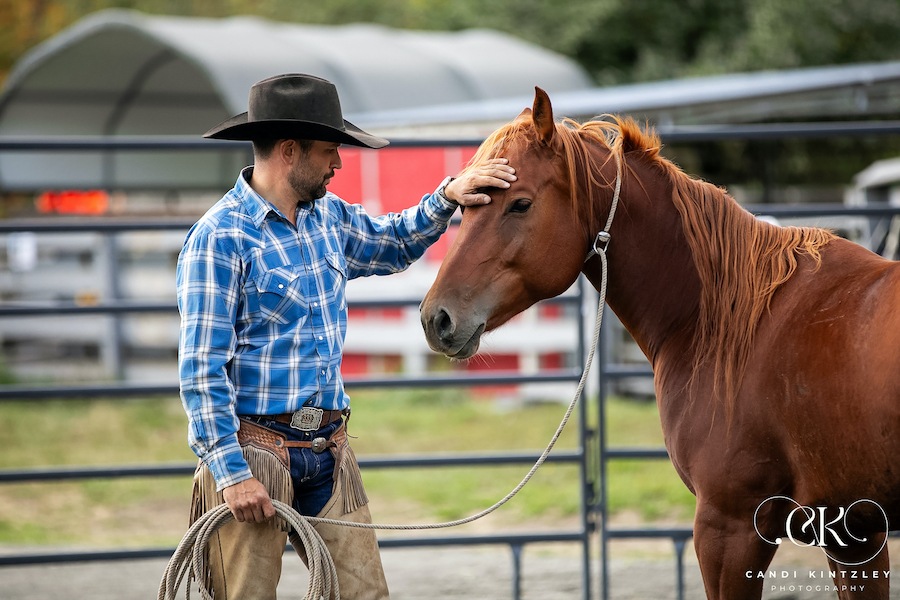
Harissa’s Progress
For us, it begins in a muddy field.
Harissa stands with her herd, four mares total, perhaps aunts or cousins or sisters, bound if not by blood then by the unfortunate nature of their circumstances. They squelch through the muck as they approach us, curious, wary. While some can be haltered, none allow themselves to be led, and we must usher them to the trailer loose, a 16-legged unit careening down a panel chute towards a new life.
At SAFE, we make slow introductions, hoping to work a tangle from a mane and curry some mud from a leg. For the most part, they are shy, hesitant – out of practice with being handled, or perhaps mostly new to it. They must get to know us just as we get to know them.
Harissa, however, already knows us.
Not us, who stand before her now, but Us, meaning our kind, meaning humans. She knows us, and she could do without. Some part of Harissa learned that fight was preferable to flight, and she is not afraid to show us her teeth.
There is sadness that accompanies rescue stories. The bag of bones horse, the worm-infested horse, the horse with the feet that have started to curl in on themselves. But there is arguably more sadness in a story like Harissa’s, the horse who, through whatever fault of Ours, learned that the best option was to grow fangs.
Harrisa is not a bad horse, she is a supremely sad one.
Gentling horses is not without its difficulties even in the best of cases, but for a horse like Harissa, the task at hand seems almost insurmountable. The first of many sessions in the round pen show us this. She is herdbound, pawing great trenches in the sand when removed even 50 feet from her friends, unable to find any sort of peace. She pushes into pressure with an intensity that is dangerous both for her and the person on the end of her emotional (or physical) line. She strikes out, quick and unpredictable.
In amongst the work, we give her time.
She eats three meals a day now. Her feet, overlong, are as untouchable as the rest of her, but begin to shave themselves down on the hard ground of her paddock. We pick the manure from her pen in the mornings, and again in the afternoons. We keep a watchful eye on her while we do, but for the most part, we largely ignore her. There is no presumption here, no expectation.
Around her, her herdmates progress through the motions. They work up to wearing halters, to being brushed all over, to having their hooves seen to. They leave the paddock, they meet the vet, they slide more firmly into domesticity. Some begin to wear saddles – some even become riding horses. Meanwhile, Harissa is given space.
When Joel comes, he works with her. Such has been the case since the very beginning. Joel in the lion’s den on that first day, dodging her teeth, looking for a positive change to leave her on. Ask any one of us, back in May, and we would be honest in telling you it seemed near impossible.
But with each visit, there is evidence of cracks in her facade, ways in which we are getting through to her. Even something as simple as stopping at the opposite side of the round pen from where her friends are, or giving to pressure in the smallest of increments are big changes, a new foundation. Brick by brick, we help Harissa to rebuild — hard work the material, time and patience the mortar.
Time, work.
Then, there comes a day when Harissa feels the slack leave the rope, and searches for a way to reintroduce it.
More time, more Work.
Then, there comes a day when Joel slides his hand down Harissa’s face and she does not pin her ears.
Followed closely by a day where he can slip his hands around her neck and put her in a halter, work with her on a shorter line, touch her with a flag. All milestones that, for some horses, take just days, hours, even minutes. But with Harissa, time stands still. Her journey has no end date.
Work, time.
We can now approach her in her paddock, and she will meet us half-way. She lets us comb out the tangles from her mane – finally – and pet down her legs. Her eyes are soft as we stroke her cheek, and we tell her that the dab of white in the middle of her forehead very much resembles a heart. She sees the vet (but that’s a story for another day), and meets the farrier. She grows a little more domestic from one month to the next.
We are still cautious. There are parts of Harissa which remain that are mistrustful of people, of Us. Hers is not a blank slate, and there is writing on the wall that has left a deep imprint. There is no switch to be flipped overnight, no sudden rearranging of a personality. Just gradual change, facilitated by, what other than, work and time.
But when the road ahead begins to look particularly long, we look back, and we see how far she has already come.
Today, Harissa’s journey continues. We take it step by step, day by day, the way we have from the beginning.
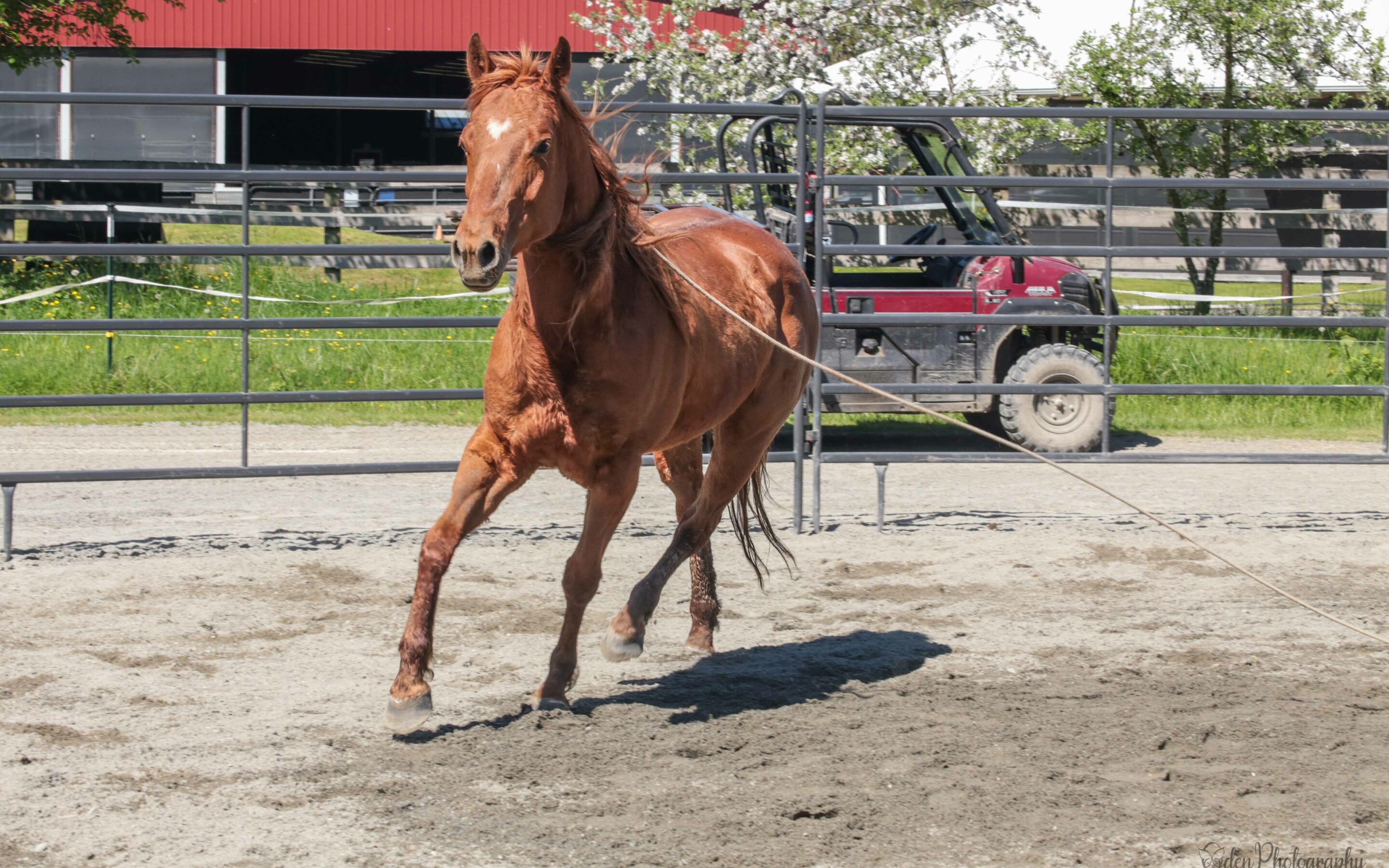
Introducing Harissa
Some stories, by their very nature, take a bit longer to tell than others. Harissa’s story will be one of these, especially when framed alongside the others she came in with, who are steadily trucking along in their training, checking off boxes and working towards true domesticity.
On the property from where she came, Harissa was living in the four mare herd alongside Mirana, Meadow, and Wren. She and Wren were the more wary members of the group when it came to humans, but it became clear to us in simply watching the mares interact with one another that Harissa was, to her horse peers, high up in the ranking. It was also clear that she had tried some of those same lead mare behaviors on humans, and that they had worked.
What I mean to say is that Harissa had a spot in there where she turned nasty. At the suggestion of being pet, her initial reaction was not to flee like the rest of her peers, but to strike out. All horses are an unknown quantity when they first arrive, but Harissa proved early on exactly how these unknown quantities can sometimes be dangerous.
When we got her in the round pen for the first time, this behavior only intensified. We roped her, as is the common first step in our halter starting practice, but instead of giving to pressure, not only was she pushing against it, but lunging at the person on the other end of the line. She was also incredibly herd bound to the point where she was completely unable to use her thinking brain. When offered a release, she was unable to find any relaxation whatsoever, and spent her time pawing great trenches in the sand. Even when we brought the hose out, since the day was so hot, she hardly even registered that she was being sprayed, so caught up in her anxieties was she.
A horse like Harissa is one of the most heartbreaking, because she has clearly had some experiences with people that have led her to not only find no comfort in humans, but to mistrust them to the point of aggression.
So we needed to rethink our strategy for Harissa’s success. The first step would be giving her a bit more time to settle in, to limit the people who came into contact with her, to show her that we don’t always expect things from her. And so far, the time has done her good. She is curious of the people she interacts with, and seems to be developing a better view of people by the day. She still has a long way to come, and we are still exercising caution around her to ensure that she has the best chance at future success, but we do believe that with a lot of time and patience, she can learn to trust in people, maybe for the first time ever.

Introducing the Gig Harbor 7
The majority of the horses who come to SAFE come as singles or in pairs. One here, one there, typically with some space in between arrivals. But on occasion, we are called to assist with a larger seizure. It hasn’t been all that long since the Fall City 40, and an even shorter period since we took in the Graham 27. Now, we were once again called to help with a multi-horse intake. Seven horses in the Gig Harbor area needed our help, the owner needing to quickly re-home horses that were not easily re-homeable. On the heels of the Graham horses, we felt a bit more prepared for a larger intake, but unlike the Graham horses, these horses had not had regular (or any) handling in some time.
So on a Saturday morning, we loaded up our trailers with panels, and set out with a robust team of people and a brigade of trailers and a plan to pull seven horses out of the mud.
Thanks to a ton of planning, a great deal of manpower, and an earlier scope of the property, we were able to successfully remove all the horses from the property over the course of just a few hours. We ran chutes from the pens, some quite winding and intricate, but everyone left unscathed, and arrived at SAFE in one piece.
Lancelot, the stallion, was the first to pull through the gates.
Next were mother and daughter, Ciara and Inula,
followed by the small herd of mares: Meadow and Mirana, the elders of the group, (and the only ones who allowed us to halter them), and Wren and Harissa.
Seeing them at SAFE was like seeing them with the lights clicked on for the first time. It was clear they were in need of some TLC, but out of the mud and muck, it became obvious just how much. Their feet were overgrown, slippered in some cases. The four mares had a line of what appeared to be rotten hair halfway up their legs, likely a result of standing in a high layer of wet ground. The mother and daughter stank, a smell like rotting, and while there was nothing visibly deceased on the property, it felt very much like a place where death lived. All of them, when confronted with clean water troughs, drank long and deep.
It was clear from the moment we set eyes on the horses that they would take some work to rehab and retrain. Even the mares who let us halter them were not keen on being touched much beyond that. We certainly had our work cut out for us. But this was not the first time that challenging horses had come through our gates, and it will not be the last. The road ahead might be long, but the most important thing is that these horses are safe now, and that is all that matters.
Harissa’s Friends:
1. Jennifer S.
2. Marilyn P.
3. Kate & Julia L.
4. Christine D.
5. Gina C.
6. Catherine V.
7. Jane M.
8. Madison D.
9. ____________________
10._____________________
Every horse deserves at least ten friends! Even a small monthly donation can make a difference. Plus, SAFE horse sponsors receive discounts at local businesses through the SAFEkeepers program!

